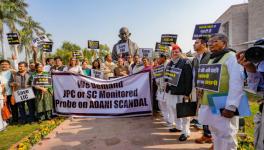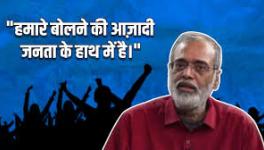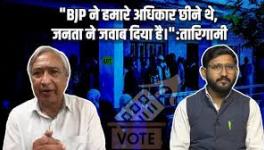Has BJP Really Won the Assam Panchayat Polls?

The results of the recently held Assam panchayat election prove the adage that every win is not a victory, and some defeats are only instalments to victory. Although the ruling Bharatiya Janata Party (BJP) government has won as expected, its lead over the Indian National Congress (INC) proves that the show is not over, especially when the rural polls were being dubbed as a semi-final to the coming 2019 Lok Sabha polls.
While BJP has won 217 out the 420 Zila Parshad seats, INC is not far behind with its tally of 147 — only 70 seats behind. At the lower strata of the panchayat polls too, the Congress party is not far behind the ruling BJP. Out of the 2,192 declared seats for the Gaon Panchayat President posts, Congress grabbed 759 seats, while BJP clinched 991 seats. The INC is trailing the BJP by only a margin of 232 seats.
Also Read: Assam on the Boil as NRC Updating Gives Rise to Insecurity
In the fray for the posts of Anchalik Panchayat Member, the difference between the ruling BJP and the Congress party is only 251. Out of the results of 2,186 seats declared, the BJP received the people's mandate in 1,020 seats, while Congress got 769 seats. In the third category, Gaon Panchayat Ward Member, which has the maximum number of seats, 20,990, the Congress clinched 6,971 seats, while BJP grabbed 8,730 seats. Here again the Congress has given the BJP a tight fight — as the difference of numbers between the parties is only 1,759. This tight race in rural Assam indicates that in the forthcoming Lok Sabha polls next year, it is not going to be a cakewalk for BJP.

The Changing Numbers
In Assam, the trend so far has been that the ruling party always wins the rural polls by a huge margin ahead from the second ranker, but this time it was different. In the 2013 Assam rural polls, the ruling Congress had won 273 seats, while the second-ranking All India United Democratic Front (AIUDF) could grab only 76 seats, with BJP making it to only 15 seats. The regional sentiment-bearer Asom Gana Parishad (AGP), which had formed governments twice in the state in 1985 and 1996, got only 29 seats in 2013. This time in 2018, AGP got even fewer ZPC (Zila Parishad constituency) seats, only 19 — almost washed away — even after hurling several threats to pull itself away from its ruling alliance with the BJP in the state, citing and opposing the controversial Citizenship (Amendment) Bill 2016, which BJP is trying to put on the table in the winter session of Lok Sabha, the last session before its 5-year term is over in the centre.
Also Read: Assam: Indefinite Detention for Those Without Documents
The Citizenship (Amendment) Bill 2016 seeks to secure citizenship for prosecuted minorities — mainly Hindus — migrating from Bangladesh, and other countries. AGP and 70 other Assamese organisations have been agitating against the bill — dubbing it communally driven — since the process of the National Register of Citizenship (NRC) kicked off in the state under the supervision of a Supreme Court bench headed by Chief Justice of India Ranjan Gogoi. Apart from the Assamese organisations, Bengali-origin Muslims of Assam also have voiced concerns against the bill. The bill played a major role in the rural polls this time in Assam. At one point, it seemed that the BJP was losing its ground as it has been so far unable to get the bill passed for the Bengali Hindus living in constant fear of being left out of the citizenship register, with the mainstream Assamese organisations going against the bill that BJP had created. AGP also interestingly decided to contest the panchayat polls on its own. The fear for BJP was, thus to lose both Assamese and Bengali Hindu votes, which has not actually happened, as evident from the rural poll results.
Now, however, the picture is different. The BJP is all set to form at least 13 out of the 27 Zila Parishads on its own, and in case of alliance with AGP, there may be chances of BJP and AGP together forming three more Zila Parishads. BJP has bagged absolute majority in Tinsukia, Dibrugarh, Sonitpur, Kamrup, Kamrup Metro, Biswanath, Lakhimpur, Nalbari, Golaghat, Charaideo, Dhemaji and Assam Chief Minister Sarbananda Sonowal’s constituency Majuli — all districts falling in the core tribal-plus Assamese region. Apart from the Assamese region, the BJP has also captured the Bengali heartland Barak valley's Cachar district Zila Parishad. As for Congress, they are likely to form the rural bodies in five districts — Barpeta, Karimganj, Jorhat, Morigaon and Dhubri. With the help of AIDUF, they can peg in two more districts, which are: Hojai and Goalpara. AIUDF alone is left with only two Zila Parishads — in Hailakandi and South Salmara-Makachar districts, becoming the biggest losers in this round of rural polls followed by AGP.
Why the Big Change?
So, why the big differences for AIUDF and AGP, and how could Congress grab so many ZPC seats, despite reports of infighting in the party for nominations? Even after the polls, three-time Congress minister Nurjamal Sarkar has sought party state president Ripun Bora's resignation. Talking to this correspondent, Sarkar claimed that despite repeated requests, Ripun Bora did not give nominations to any of the candidates he had chosen for several ranks of the rural body in Sarkar's home constituency Biswanath, which BJP eventually grabbed, along with Bora’s own constituency Sonitpur, also clinched by the BJP. Similar instance happened in Hailakandi district as well, where a number of the winners from the AIUDF had initially sought Congress nominations. Despite all the factors — Congress infighting, BJP’s differences with its ally AGP, AIUDF’s supposedly strong Muslim base – everybody was taken aback by the results. The results can be explained only by considering the following five factors.
The Five Factors
1. Incumbency supported BJP: While everything in the rural structure was under the Congress, it was obstructed by the BJP which controlled the state assembly and won the Lok Sabha polls. People prefer to have their local body representatives from the same party that is holding the State government so that there remains a direct connection between the local representative and the state ministers. Also, there is a perception that there is less ground-level corruption underthe BJP rule compared to the Congress’s rule earlier. This perception has been strengthened when the BJP-led government started a big drive against the alleged scams in the Assam Public Service Commission (APSC) that happened during the Congress era.
2. Anti-Incumbency among Minorities: Anti-incumbency has an entirely different dimension in Assam. Muslims voted in favour of Congress this time in most cases. BJP's nationwide anti-Muslim rhetoric and campaigns, the party’s attempt to malign all Bengali Muslims in the state as infiltrators pushed the Muslims to zero-in on the larger goal and a party. While in 2013 and 2016, it was the regional Muslim messiah Badaruddin Ajmal's AIUDF that got a massive mandate of the Muslims, this time the Muslims felt that this had helped BJP clinch power in the state. So, they decided to vote for Congress instead. Some other factors included the fall of industries in Assam, which fuelled the anger of a section of the working class of both Hindu and Muslim, as well as both Bengali and Assamese.
3. Mix of Communalism and Regionalism: The BJP has been successful in wooing the voters through its effort to place a mix of regional sentiments and communalism on the platter. The saffron party has received maximum votes and captured districts mainly in the Assamese heartland where regionalism worked because of the NRC. Even though the Assamese organisations, including ULFA and AGP, have been shouting slogans against the Bengali Hindus, the decades-old myth of Muslim Bangladeshi had an actual impact in rural belt of Assam. The panchayat results and the failure of the Assamese organisations are proof to the fact that the anti-Bengali Muslim wave that has been at the core of the politics of Assam, has not waned at all. There have been rumours of Muslim infiltrators capturing the Satra lands, there was Sarbananda Sonowal who had gained the title of "Jatiya Mahanayak" (People's Hero) because of his successful bid to annul the contentious Illegal Migrants (Determination by Tribual) [IMDT] Act — all this worked for the BJP. Again, the BJP's remarkable performance in the Bengali dominated Cachar district proves that its effort to table the Citizenship (Amendment) Bill has been graced by at least the Bengali Hindus.
4. AGP's Changing Positions and NRC: AGP has been saying for more than a year now that it would cut the tie with BJP, but has not done so. Finally, they fought alone in the rural polls, a decision that has actually boomeranged, and both BJP and Congress gained from its dillydallying. Nagaon, a district that had been the stronghold of AGP's two-time CM Prafulla Kumar Mahanta, has given BJP 12 ZPC seats, 11 to the Congress party, while AGP got only 3 seats. The regional party received maximum seats in Bongaigaon district where it bagged 5 seats out of the total 12, while Congress got 3 seats, BJP and AIUDF each respectively, have 2 seats. The fight in the district was mainly between the Assamese versus Bengali voters. AGP's dwindling position regarding the NRC also created a polarisation between Congress’s Muslim vote bank and BJP’s Hindu Bengali-plus-Assamese vote bank. Congress is the gainer in the Muslim Bengali dominated areas, while BJP has taken away the Hindu Assamese and Bengali votes. AGP had a strong base among the Bengali Muslims in some pockets because of the presence of some Bengali leaders such as late Sahidul Alom Choudhury from Barak valley.
5. Doles of Jobs: BJP leader Himanta Biswa Sarma has been famous for the creation of thousands of school jobs in his stint as the Education Minister, which is continued till now under his successor Siddhartha Bhattacharya. Apart from this, the government recruited more than a thousand educated youth in the Panchayat and Rural Development (PNRD) department in 2018, while the Directorate of Health Services also announced to dole out hundreds of Grade-3 and 4 jobs right before the Panchayat polls. These jobs helped BJP reap the benefit of votes of a large chunk of youth in the state.
What Remains for the Grand Finale?
As the Assam Panchayat Elections 2018 are being dubbed as the semi-final before the coming Lok Sabha polls sometime early in 2019, what is to be seen is whether the Congress party can at least maintain its status achieved in the rural polls, whether AIUDF vanishes completely and AGP regains its glory. The predictions say the Congress — with its streak of success in the recently held by polls in Karnataka, the assembly elections in Madhya Pradesh, Rajasthan and Chhattisgarh and the success in Assam panchayat polls — may be able to regain its glory in the North eastern state as well, while for BJP, the Lok Sabha polls is a fight to get back its lost glory in the recent rounds of polls across states.
Also Read: Will Assam Burn While BJP Fiddles With the Citizenship Bill?
However, the recent poll results, including those of the Assam rural polls, indicate one thing certainly — that the fight in the coming Lok Sabha elections is going to be a tough one for the BJP, ruling both in the centre and Assam.
Taha Amin Mazumder is an Independent Content Management Consultant based in Guwahati.
Get the latest reports & analysis with people's perspective on Protests, movements & deep analytical videos, discussions of the current affairs in your Telegram app. Subscribe to NewsClick's Telegram channel & get Real-Time updates on stories, as they get published on our website.























